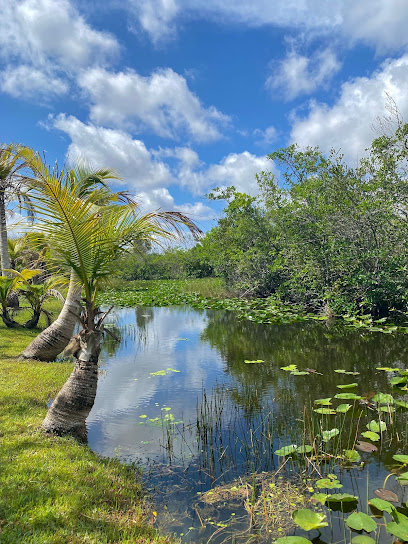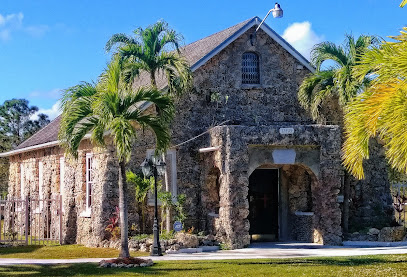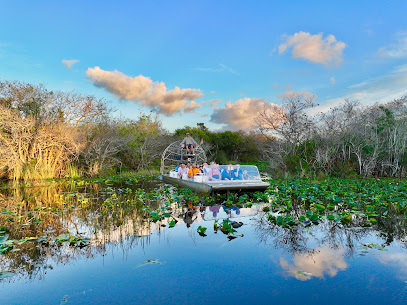
Explore the Majestic Everglades: A Natural Wonder of Florida
Discover the Everglades, Florida's stunning wetland paradise, rich in wildlife and natural beauty, ideal for eco-adventures and unforgettable experiences.
The Everglades, a UNESCO World Heritage site, is an expansive wetland paradise in Florida, teeming with unique wildlife and breathtaking landscapes. Ideal for eco-adventures and nature lovers, this vast expanse offers visitors a chance to disconnect and immerse themselves in a world of natural beauty.
A brief summary to Everglades
- Florida, US
Local tips
- Visit during the dry season (November to April) for the best wildlife viewing opportunities.
- Consider taking an airboat tour for a unique perspective of the wetlands and its wildlife.
- Pack plenty of water and snacks, as some areas are remote and lack facilities.
- Wear sunscreen and insect repellent to protect against sunburn and bug bites.
- Bring binoculars for birdwatching and spotting wildlife from a distance.
Getting There
-
Car
If you're driving, the main access point to Everglades National Park is via US Highway 41 (Tamiami Trail). From Miami, take the US-41 W exit from I-95 S. Follow US-41 W for approximately 35 miles until you reach the Ernest F. Coe Visitor Center. There is a $30 entrance fee per vehicle, valid for 7 days.
-
Public Transportation
For those relying on public transportation, take the Miami-Dade transit bus route 37 from Miami to the nearest stop at the entrance of the park. Be aware that public transport options to the park are limited, and it may be advisable to rent a vehicle or use a rideshare service once inside the park.
-
Bicycle
If you're already within the park and looking to explore further, consider renting a bicycle. There are designated bike paths throughout the park. Just make sure to wear a helmet and stay hydrated, especially in the warmer months.
-
Park Shuttle
During peak seasons, the park may offer shuttle services to popular destinations within the park, such as the Anhinga Trail or Flamingo Visitor Center. Check the National Park Service website for the latest schedule and pricing information.
Discover more about Everglades
Iconic landmarks you can’t miss
Everglades
0.0 km
Discover the Everglades, Florida's stunning wetland paradise, rich in wildlife and natural beauty, ideal for eco-adventures and unforgettable experiences.

Tamiami Trail
4.9 km
Explore Tamiami Trail: A breathtaking journey through Florida's stunning landscapes and diverse attractions, ideal for nature lovers and road trip enthusiasts.

ValuJet Flight 592 Memorial
11.9 km
Visit the ValuJet Flight 592 Memorial in Miami to reflect on resilience and remember the lives lost in the tragic 1996 aviation accident.

Gold Coast Railroad Museum
21.1 km
Discover the captivating history of Florida's railroads at the Gold Coast Railroad Museum, a family-friendly attraction in Miami.

Cauley Square Historic Village
26.5 km
Experience the allure of history at Cauley Square Historic Village, a unique destination with antique shops, dining options, and beautiful gardens in Miami.

Historic Walton House
27.9 km
Discover the Historic Walton House: A stunning wedding venue in Homestead, Florida, rich in history and surrounded by beautiful gardens.

Curtiss Mansion
28.2 km
Discover the elegance and history of Curtiss Mansion, a captivating landmark in Miami Springs, blending architectural beauty with cultural events.

Heritage Market
28.9 km
Explore the vibrant Heritage Market in Homestead, Florida, for fresh produce, gourmet foods, and unique local crafts in a lively farmers' market setting.

Coral Gables City Hall
29.2 km
Explore the architectural beauty and cultural significance of Coral Gables City Hall, a stunning landmark in Florida's charming Coral Gables community.

Merrick Park
29.2 km
Discover the serene beauty and vibrant culture of Merrick Park, a stunning urban oasis in the heart of Coral Gables, Florida.

Miami Historic Homes
29.3 km
Experience the architectural splendor and rich history of Miami's Historic Homes in Coral Gables, a true gem of cultural heritage.

Coral Gables Historic Resource
29.5 km
Discover the historical charm of Coral Gables at the Historic Resource, where architecture and culture converge in a picturesque setting.

Miracle Mile & Downtown Coral Gables
29.7 km
Explore Miracle Mile & Downtown Coral Gables: A hub of shopping, dining, and cultural experiences in a picturesque Mediterranean setting.

The Ruins
29.8 km
Experience the beauty of nature and elegance at The Ruins, the premier event venue in Coral Gables, Florida, perfect for all occasions.

Marjory Stoneman Douglas Historic Home
30.5 km
Explore the Marjory Stoneman Douglas Historic Home, a tribute to Florida's environmental heritage and a serene escape into nature's beauty.

Unmissable attractions to see
Gator Park
3.1 km
Experience the thrill of the Everglades at Gator Park, where adventure meets nature in Miami's wildest attraction.

Everglades National Park Tours
3.1 km
Discover the wonders of Everglades National Park Tours, where adventure meets nature in Florida's stunning wetlands.

Everglades Safari Park
7.3 km
Explore Everglades Safari Park – an unforgettable adventure in Florida's unique ecosystem with airboat rides, wildlife encounters, and stunning natural beauty.

Captain Willy Everglades Tours
7.6 km
Experience the breathtaking beauty of the Florida Everglades with Captain Willy Everglades Tours, where adventure meets nature.

Everglades River of Grass Adventures
7.6 km
Experience the breathtaking beauty and diverse wildlife of the Everglades with unforgettable boat tours at River of Grass Adventures.

Miami ATV Rentals
13.0 km
Discover the thrill of off-roading in Miami with ATV Rentals, where adventure meets the stunning landscapes of Florida.

Everglades and Francis S. Taylor Wildlife Management Area - WCA 3B
14.8 km
Discover the breathtaking beauty and diverse wildlife of the Everglades and Francis S. Taylor Wildlife Management Area, a true nature lover's paradise.

MyTravels & Tours Corp
16.2 km
Discover Miami's vibrant culture and breathtaking sights with personalized tours from MyTravels & Tours Corp, your key to unforgettable adventures.

BAY OF PIGS AIR MEMORIAL
16.4 km
Discover the Bay of Pigs Air Memorial in Miami, a poignant tribute to bravery and a deep dive into a pivotal moment in Cuban-American history.

ZWF Miami
16.9 km
Discover ZWF Miami, an enchanting wildlife refuge where you can connect with exotic animals and learn the importance of conservation in a serene setting.

Patricia and Phillip Frost Art Museum
18.2 km
Discover the Patricia and Phillip Frost Art Museum, a hub of creativity and culture in Miami featuring diverse art collections and exhibitions.

Shark Valley Tram Tours
21.1 km
Discover the breathtaking beauty of the Everglades with Shark Valley Tram Tours – a perfect blend of adventure and nature awaits you.

Shark Valley Visitor Center
21.1 km
Discover the wonders of the Everglades at Shark Valley Visitor Center, where nature and adventure come together in Miami's stunning wetlands.

Otter Cave Hammock Trail
21.2 km
Explore the serene Otter Cave Hammock Trail in Miami, a perfect getaway for nature lovers and hiking enthusiasts seeking tranquility amidst lush landscapes.

Balloon over miami
21.6 km
Experience Miami from the sky with Balloon Over Miami, offering breathtaking views and unforgettable aerial adventures.

Essential places to dine
94th Aero Squadron Restaurant
27.1 km
Dine amidst aviation history at Miami's 94th Aero Squadron Restaurant - where great food meets spectacular views.

Graziano's Restaurant Coral Gables
29.3 km
Experience authentic Argentinian cuisine at Graziano's Restaurant in Coral Gables - where every dish tells a story.

Seasons 52
29.4 km
Discover the essence of New American cuisine at Seasons 52 in Coral Gables—where seasonal flavors meet fine dining elegance.

Caffe Abbracci
29.4 km
Experience authentic Italian cuisine at Caffe Abbracci in Coral Gables - where every dish tells a story of Italy's rich culinary heritage.

TUR Kitchen
29.5 km
Experience exquisite Mediterranean cuisine at TUR Kitchen in Coral Gables - where tradition meets contemporary flair.

Bulla Gastrobar
29.7 km
Discover authentic Spanish cuisine at Bulla Gastrobar in Coral Gables—where every dish tells a story and every drink delights the senses.

Portosole
29.7 km
Experience exquisite Italian and seafood dining at Portosole in Coral Gables - where culinary artistry meets elegance.

Lion & The Rambler
29.7 km
Discover culinary excellence at Lion & The Rambler in Coral Gables - where innovative dishes meet exquisite wines in a charming atmosphere.

Zucca
29.7 km
Experience authentic Italian cuisine and creative cocktails at Zucca in Coral Gables - where every meal is a celebration of flavor.

Eating House Miami
29.8 km
Experience the vibrant culinary scene at Eating House Miami - where comfort food meets innovation in Coral Gables.

CRAFT Coral Gables
29.8 km
Discover exquisite breakfast and brunch at CRAFT Coral Gables - where New American cuisine meets local charm.

Chimichurri Grill
29.8 km
Experience authentic Argentine cuisine at Chimichurri Grill in Homestead - where every meal is a celebration of flavor.

Sweet Bakery Cafeteria
30.1 km
Discover authentic Cuban flavors at Sweet Bakery Cafeteria in Homestead, where delightful pastries and hearty breakfasts await.

El Nicamex Restaurant
30.1 km
Discover the vibrant flavors of Nicaragua at El Nicamex Restaurant in Homestead – where every meal tells a story.

Soriano Brothers Cuban Cuisine
30.2 km
Experience authentic Cuban flavors at Soriano Brothers Cuban Cuisine in Homestead, where delicious breakfasts meet vibrant cultural dining.

Markets, malls and hidden boutiques
Shell
7.6 km
Conveniently located in West Miami, the Shell station offers gas, snacks, and meals to fuel your adventures in the city.

Escape N Vape Smoke Shop
11.5 km
Discover a premier destination for tobacco, cannabis, and vaping supplies in Miami at Escape N Vape Smoke Shop.

Walgreens
11.7 km
Experience the convenience of Walgreens in Miami: your go-to destination for health, beauty, and everyday essentials.

Grain of Sand by Aneth
11.8 km
Explore Grain of Sand by Aneth for exquisite handcrafted jewelry and fashion accessories in the heart of Miami, perfect for every occasion.

ALDI
11.9 km
Discover unbeatable prices on quality groceries at ALDI in Kendall, Florida - perfect for tourists looking to save.

GameStop
11.9 km
Explore Miami's GameStop for the latest games, collectibles, and a vibrant community of gaming enthusiasts in Kendall Plaza.

The Vitamin Shoppe
11.9 km
Explore Miami's The Vitamin Shoppe for an extensive range of vitamins, supplements, and natural health products in a budget-friendly setting.

MY PETS LOVE IT Fresh Natural & Organic Dog Treats in Miami
12.0 km
Discover fresh, organic dog treats at MY PETS LOVE IT, Miami's ultimate pet supply store for health-conscious dog owners.

Starbucks
12.0 km
Discover the perfect blend of comfort and flavor at Starbucks in Miami's West End, your go-to coffee destination.

Five Star Jewelers
12.0 km
Explore the exquisite collection at Five Star Jewelers in Miami, where luxury meets expert craftsmanship and exceptional service.

Dania's Fashion Boutique
12.2 km
Explore feminine elegance and unique styles at Dania's Fashion Boutique, your go-to destination for women's clothing, swimwear, and exquisite perfumes in Miami.

La Maison Boutique
12.3 km
Discover unique women's fashion at La Maison Boutique, where style meets sophistication in the heart of Miami's vibrant West End.

Walmart Supercenter
12.6 km
Experience the ultimate shopping destination at Walmart Supercenter in Kendall, offering everything from groceries to electronics at budget-friendly prices.

Luxe Fashion Boutique
13.0 km
Explore Luxe Fashion Boutique in Miami for high-end, curated fashion pieces that elevate your style and make a statement.

Hola Lola Boutique
13.7 km
Discover stylish apparel and personalized service at Hola Lola Boutique in Kendale Lakes, Florida - a must-visit for fashion enthusiasts.

Essential bars & hidden hideouts
Miccosukee Casino & Resort
7.3 km
Discover the thrills of Miccosukee Casino & Resort in Miami, where gaming excitement meets luxurious relaxation and cultural heritage.

Tempt Lounge
7.3 km
Discover the allure of Tempt Lounge, where innovative cocktails and vibrant nightlife create the ultimate Miami experience.

Walk-On's Sports Bistreaux - Kendall Restaurant
12.2 km
Discover the ultimate sports dining experience at Walk-On's Sports Bistreaux in Kendall, Miami - where flavor meets excitement in a lively atmosphere.

Strange Beast
12.7 km
Discover Strange Beast, a brewpub in Miami offering unique craft beers and delicious pizzas in a vibrant atmosphere.

Mellow Grapes Miami
13.1 km
Discover the exquisite world of wines at Mellow Grapes Miami, where every sip tells a story in a cozy and inviting atmosphere.

Eddie's Place
15.6 km
Discover the lively nightlife at Eddie's Place, Miami's premier bar with cocktails, karaoke, and sports entertainment for an unforgettable experience.

Big Cypress Distillery
17.6 km
Discover the art of craft spirits at Big Cypress Distillery in Miami, where quality liquors, delicious food, and a vibrant atmosphere await you.

Keg South Of Kendall
17.8 km
Discover Keg South Of Kendall, a lively American restaurant and pub in Miami offering delicious food, sports entertainment, and a vibrant atmosphere.

KROME Sports Grill
19.8 km
Discover the vibrant atmosphere of KROME Sports Grill, where delicious cuisine meets Miami's lively nightlife in a welcoming bar setting.

Club glades
25.0 km
Experience electrifying nightlife at Club Glades, the ultimate bar and club in Homestead, Florida, where music, drinks, and fun collide.

The Cellar Club Bar
27.7 km
Experience upscale brunch and refined cocktails at The Cellar Club Bar, a hidden gem in Coral Gables' historic Biltmore Hotel.

Natural Beauty Bar
28.5 km
Experience tranquility and delightful refreshments at Natural Beauty Bar in Homestead, Florida—a perfect retreat for relaxation seekers.

Keg South of Homestead
28.8 km
Experience the best of American dining at Keg South of Homestead, where hearty meals and vibrant atmosphere await you.

Miami Brewing Company
29.0 km
Discover the vibrant craft beer scene at Miami Brewing Company, where local flavors and artisanal brews come together in a lively gastropub setting.

The Globe
29.3 km
Experience the vibrant flavors and live jazz at The Globe, Coral Gables' premier grill and bar for an unforgettable dining adventure.




